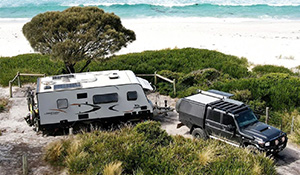How To: Dirt Road Driving
Words Dean Mellor
There are approximately 910,000km of roads in Australia, of which only 350,000km are sealed, so sooner or later you’re going to find yourself driving on one of the 560,000km of dirt roads that criss-cross this massive continent.
Driving on dirt is very different to driving on the blacktop and, for the uninitiated, that very first experience on a slippery surface can range from a little intimidating through to downright scary.
There are many different types of unsealed roads in Australia, ranging from good quality gravel-covered roads to crook, potted and bulldust covered outback tracks, and everything in between. Before you tackle dirt, you should try to figure out exactly what conditions you can expect. There are several ways to do this from reading maps to checking local conditions at the nearest town, or by checking with the relevant state roads authority, either by phone or online.
You’ll also need to make sure your vehicle is up to the task of driving on the dirt roads ahead. For starters, it’ll need tyres with plenty of tread and suspension that’s in good condition. And you’ll need to carry a tyre repair kit, tyre pressure gauge and air compressor.

Vehicle set-up
Running in four-wheel drive on dirt roads will give you much more traction than two-wheel drive, which will result in better vehicle control, so the first thing you need to figure out is what sort of 4x4 system your vehicle is equipped with.
If you drive a vehicle with an old school part-time 4x4 system, you’ll have to manually engage four-wheel drive when you hit the dirt, either via a lever attached directly to the vehicle’s transfer case or an electrically operated switch or dial. If your vehicle has manually operating free-wheeling hubs, you’ll have to pull over and make sure they’re in the locked position before engaging four-wheel drive.
If your vehicle has a full-time 4x4 system, you should lock the centre differential to ensure a 50:50 torque split between front and rear axles. This might not be necessary on some modern high-tech 4x4s such as the Volkswagen Amarok, or vehicles fitted with a mode-selectable 4x4 system with a ‘gravel’ setting such as Ford Everest or Land Rover Discovery.

Tyre pressures
The next thing to do is check your tyre pressures. While 35psi might be fine on the road, it’ll be too high for rough gravel and dirt roads, so you’ll need to let some air out. Lowering tyre pressures will improve ride quality and reduce the risk of tyre damage, including chipping across the tread area and the potential for punctures.
There’s no ‘correct’ tyre pressure for driving on dirt as there are so many variables, such as the vehicle itself, the load it’s carrying and the condition of the road. If the gravel road is in good nick, and you can easily maintain a similar speed to when you were driving on the blacktop, you can probably leave your tyre pressures as they were. But if the road surface is rough and you have to lower your speed, you should think about lowering tyre pressures.
If you were running 38psi on the road, drop pressures to 32psi on rough gravel and see how it feels. If you were running 30psi on the road then 26psi might be appropriate on crook gravel roads and tracks. Again, you will have to see how the vehicle feels. If ride quality is still too harsh, you might have to drop pressures further, but if handling starts to feel all sloppy and cornering is affected, you may have gone too far. Remember, as you lower pressures, the tyres will generate more heat, so you should lower vehicle speed to compensate.

Dust
When you’re driving on dirt there’s going to be plenty of dust, kicked up by your own vehicle as well as others travelling along the same road.
The best way to keep dust out of the vehicle’s cabin is to make sure all the windows are up, and you have the ventilation set to ‘fresh’. This will pressurise the cabin which should prevent dust from working its way past door seals and through other gaps.
If you’re travelling behind another vehicle, however, or there’s an oncoming vehicle kicking up a lot of dust, you’ll need to set the ventilation system to ‘recirculate’ until you’ve escaped the dust cloud, at which point you can go back to ‘fresh’. Of course, on heavily trafficked dirt roads, it’s often best just to leave the system on ‘recirculate’ until you’re back on the blacktop.
In very dusty conditions, your windscreen will also cop a decent coating, so make sure your wiper blades are in good nick and your vehicle’s washer fluid bottle is topped up.
If you drive a ute, there’s a fair chance any gear in the tray will receive a liberal coating of dust, especially if fitted with a soft tonneau cover, or even a hard lid or canopy. If fitted with either of the latter two options, a tailgate dust sealing kit will go a long way to keeping out dust, and in the case of a canopy a roof vent will also help by pressurising the tub area.

Finally, the best way to keep dust out of your engine is to fit a snorkel, which will source air up near the roofline. The theory is that you’re likely to drive far enough behind other vehicles so that the dust has settled enough for you to have clear visibility, so if the air intake is above your line of sight then the engine will be sourcing dust-free air.
Even with a snorkel fitted, you should still regularly check the vehicle’s air filter and clean it if necessary, either by giving it a tap on a tyre or, better still, attacking it with an air hose.

Stay out of the dust
As mentioned above, one of the keys to successfully driving on dirt roads is to stay out of the dust generated by other vehicles as much as possible. If you’re following another vehicle, hold back until the dust has settled. If there’s an oncoming vehicle and the dust is blowing on to your side of the road, slow down to prepare for limited visibility when driving through the dust cloud. Slowing down will also reduce the risk of windscreen damage, to both your vehicle and the oncoming vehicle.
Keep it smooth
With less traction on dirt roads than sealed roads, braking distances will be increased and cornering grip will be reduced. Bearing this in mind, drive as smoothly as possible without braking suddenly or cornering abruptly. Modern vehicles with multi-mode ABS, electronic traction control, vehicle swerve control, rollover mitigation and other electronic chassis controls have made driving on loose surfaces easier than ever, but as Toyota advised when it first introduced VSC more than a decade ago, stability control is not a cure-all for reckless driving, so take it easy.

Bulldust
Bulldust consists the finest dirt particles you’re ever likely to drive through and as more traffic passes through it the deeper it can get. You can usually pick bulldust patches thanks to slight colour variations in the road, so avoid them if possible. If you can’t avoid them, slow down a little on approach and get ready for a tug on the steering wheel as your tyres dive into the talcum-powder-like bulldust.
Keep the vehicle pointing where you want it to go and use the throttle to drive out the other side of the bulldust patch. Try to avoid braking in the middle of a bulldust patch and don’t make any sudden changes of direction.
Corrugations
Many of Australia’s unsealed roads and tracks are covered in bone-jarring corrugations and, unless you’re prepared for them, they can be almost unbearable.
I once listened to a German backpacker tell me how bad the corrugated roads were in the NT’s Litchfield National Park. Having just driven over the same roads, and thinking to myself they were in pretty good condition, I asked him what tyre pressures he was running and what speed he was travelling at. His response was 50psi and 70km/h; little no wonder his girlfriend was ready to get out of their Patrol and walk. Running 28psi in the HiLux I was driving at 90km/h, the corrugations presented little discomfort at all.
Tyre pressures are once again key to comfort and vehicle control, as is vehicle speed. As corrugations vary in height and frequency, the ideal speed on one corrugated road might not be ideal on another corrugated road. The trick is to adjust your speed until you find the sweet spot, where your vehicle’s tyres are able to skip over the top of the corrugations from one peak to another. This might be 80km/h, 90km/h or even 100km/h.

Wet Weather
When it rains, dirt turns to mud. On decent gravel roads rain will not be an issue; simply drop your speed to suit conditions and you’ll be fine. On crook dirt roads, rain can present serious challenges, especially in flat, outback country.
Many outback roads are only suitable in dry conditions, so they will be closed when wet. Because the water is unable to drain away, and because wet bulldust generally turns into a sloppy quagmire, road damage occurs when vehicles attempt to traverse these roads in wet conditions.
If you do find yourself on a wet outback road and it starts to rain, dealing with mud can be tricky. Momentum is your friend in these conditions, but you don’t want to drive so fast that you’ll lose vehicle control. Select the appropriate gear and stay on the throttle in tacky mud. Let the vehicle fall into existing tracks if it wants to (unless they look so deep you think you’ll run out of ground clearance) because the base of the tracks is likely to be firmer from being compacted by previous vehicles.
The black soils found around rivers and creeks can be extremely slippery when wet, so it’s best to avoid them if at all possible. And if you find yourself trying to descend a steep, muddy track in mountainous country, select low-range first and vary speed using the throttle, staying off the brake as much as possible, otherwise you could lose steering control.
Clean Up
Once you’re off the dirt and back on to the blacktop, make sure you reinflate your tyres to suitable road pressures. While you’re out of the vehicle, have a good look around and inspect for any damage, look for stone chips or cracks in the windscreen, make sure your headlights and taillights are clean and that your licence plate is visible.










